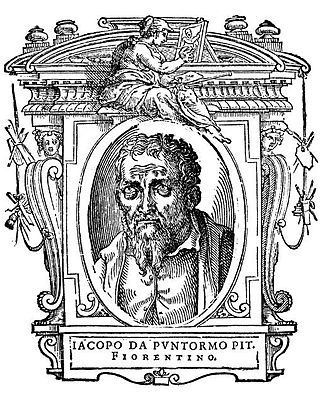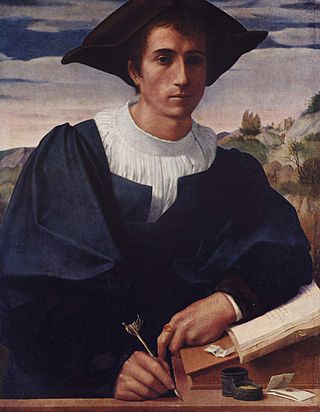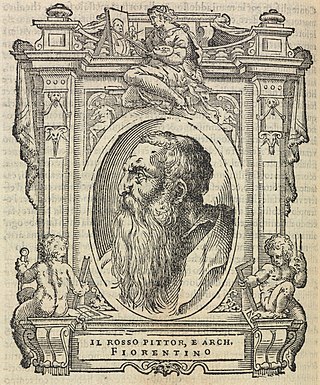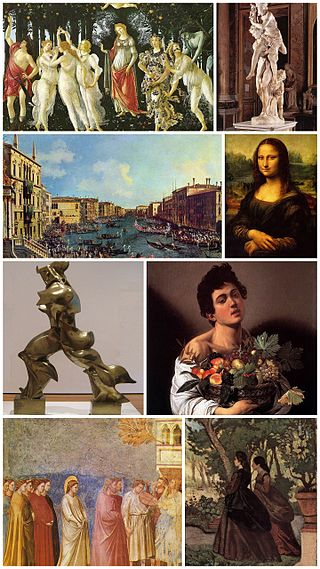
Mannerism is a style in European art that emerged in the later years of the Italian High Renaissance around 1520, spreading by about 1530 and lasting until about the end of the 16th century in Italy, when the Baroque style largely replaced it. Northern Mannerism continued into the early 17th century.

Jacopo Carucci or Carrucci, usually known as Jacopo (da) Pontormo or simply Pontormo, was an Italian Mannerist painter and portraitist from the Florentine School. His work represents a profound stylistic shift from the calm perspectival regularity that characterized the art of the Florentine Renaissance. He is famous for his use of twining poses, coupled with ambiguous perspective; his figures often seem to float in an uncertain environment, unhampered by the forces of gravity.

Franciabigio was an Italian painter of the Florentine Renaissance. His true name may have been Francesco di Cristofano; he is also referred to as either Marcantonio Franciabigio or Francia Bigio.

Agnolo di Cosimo, usually known as Bronzino or Agnolo Bronzino, was an Italian Mannerist painter from Florence. His sobriquet, Bronzino, may refer to his relatively dark skin or reddish hair.

The Descent from the Cross, or Deposition of Christ, is the scene, as depicted in art, from the Gospels' accounts of Joseph of Arimathea and Nicodemus taking Christ down from the cross after his crucifixion. In Byzantine art the topic became popular in the 9th century, and in the West from the 10th century. The Descent from the Cross is the 13th Station of the Cross, and is also the sixth of the Seven Sorrows of the Blessed Virgin Mary.

The Deposition from the Cross is an altarpiece, completed in 1528, depicting the Deposition of Christ by the Italian Renaissance painter Jacopo Pontormo. It is broadly considered to be the artist's surviving masterpiece. Painted in tempera on wood, it is located above the altar of the Capponi Chapel of the church of Santa Felicita in Florence.

Giovanni Battista di Jacopo, known as Rosso Fiorentino or Il Rosso, was an Italian Mannerist painter who worked in oil and fresco and belonged to the Florentine school.

Alonso González de Berruguete was a Spanish painter, sculptor and architect. He is considered to be the most important sculptor of the Spanish Renaissance, and is known for his emotive sculptures depicting religious ecstasy or torment.

The Descent from the Cross is the central panel of a triptych painting by the Baroque artist Peter Paul Rubens in 1612–1614. It is still in its original place, the Cathedral of Our Lady, Antwerp, Belgium. The painting is considered to be one of Rubens' masterpieces. The painting depicts the moment when the body of Jesus Christ is taken down from the cross after his crucifixion. The subject was one Rubens returned to again and again in his career. The artwork was commissioned on September 7, 1611, by the Confraternity of the Arquebusiers, whose patron saint was St. Christopher.

The cultural and artistic events of Italy during the period 1500 to 1599 are collectively referred to as the Cinquecento, from the Italian for the number 500, in turn from millecinquecento, which is Italian for the year 1500. Cinquecento encompasses the styles and events of the High Italian Renaissance, and Mannerism.

The Burial of the Count of Orgaz is a 1586 painting by El Greco, a prominent Renaissance painter, sculptor, and architect of Greek origin. Widely considered among his finest works, it illustrates a popular local legend of his time. An exceptionally large painting, it is divided into two sections, heavenly above and terrestrial below, but it gives little impression of duality, since the upper and lower sections are brought together compositionally.

Florentine painting or the Florentine school refers to artists in, from, or influenced by the naturalistic style developed in Florence in the 14th century, largely through the efforts of Giotto di Bondone, and in the 15th century the leading school of Western painting. Some of the best known painters of the earlier Florentine School are Fra Angelico, Botticelli, Filippo Lippi, the Ghirlandaio family, Masolino, and Masaccio.

The Deposition of Christ is a painting by the Italian artist Agnolo di Cosimo, known as Bronzino, completed in 1545. It is housed in the Musée des Beaux-Arts de Besançon, France. A copy by Bronzino can be found in the Palazzo Vecchio. This portrayal of the Deposition, although it depicts all the characters typically shown when Jesus is being taken down from the cross, more correctly should be characterized as a Lamentation and is an excellent example of late Mannerism or Maniera.

The Descent from the Cross is a panel painting by the Flemish artist Rogier van der Weyden created c. 1435, now in the Museo del Prado, Madrid. The crucified Christ is lowered from the cross, his lifeless body held by Joseph of Arimathea and Nicodemus.

The Entombment of Christ is a c. 1520 painting by Titian, now in the Musée du Louvre, in Paris.

San Lorenzo is a Renaissance-style, Roman Catholic church located on Via Santa Croce 2 corner with Via Luca Pacioli, in Sansepolcro, province of Arezzo, region of Tuscany, Italy. The church is known for its Rosso Fiorentino masterpiece depicting the Deposition.

The Risen Christ in Glory is an oil on panel painting by Rosso Fiorentino, created c. 1528-1530. OIt is held in the Diocesan Museum in the Città di Castello. It shows the risen Christ with Mary Magdalene, the Virgin Mary, Saint Anne and Mary of Egypt.

The Sansepolcro Deposition or Sansepolcro Lamentation is a 1528 oil on canvas painting by Rosso Fiorentino, now in San Lorenzo church in Sansepolcro.

Pietà is a c.1537-1540 oil painting by Rosso Fiorentino, originally painted on panel and later transferred to canvas. Now in the Louvre in Paris, it is the only securely-identified original painting by the artist known to have been produced for a courtier of Francis I of France. X-ray examination has shown an initial composition under the bodies of Christ and St John.

The Deposition from the Cross or Descent from the Cross is a tempera painting created by Greek painter Stylianos Stavrakis. He was active during the early part of the 1700s. His nephew and brother were also famous painters. His nephew Demetrios Stavrakis was also his pupil. He was also a goldsmith. Most of his works were completed on the island of Zakynthos. He was a representative of the Heptanese school and Greek Rococo. Fourteen of his paintings survived.





















